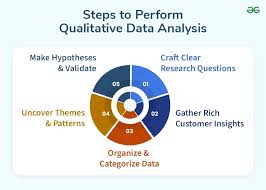The Importance of Qualitative Statistical Analysis
In the field of research and data analysis, quantitative methods have long been the dominant approach for deriving insights from data. However, qualitative statistical analysis plays a crucial role in providing a deeper understanding of complex phenomena that cannot be fully captured by numbers alone.
What is Qualitative Statistical Analysis?
Qualitative statistical analysis involves the systematic examination and interpretation of non-numeric data, such as text, images, or videos. This method focuses on uncovering patterns, themes, and relationships within qualitative data to gain insights into human behaviour, attitudes, and experiences.
The Benefits of Qualitative Statistical Analysis
Rich Insights: Qualitative analysis allows researchers to explore nuances and intricacies that quantitative data may overlook. By examining the context and meaning behind the data, researchers can uncover valuable insights that inform decision-making.
Contextual Understanding: Qualitative analysis provides a deeper understanding of the social, cultural, and behavioural factors influencing a particular phenomenon. This contextual insight is essential for making informed interpretations and recommendations.
Hypothesis Generation: Qualitative analysis can help generate hypotheses or research questions for further investigation using quantitative methods. By identifying patterns in qualitative data, researchers can formulate testable hypotheses to explore in more detail.
Methods of Qualitative Statistical Analysis
There are various methods used in qualitative statistical analysis, including content analysis, thematic analysis, grounded theory, and narrative analysis. Each method offers unique approaches to interpreting qualitative data and extracting meaningful insights.
The Role of Technology in Qualitative Analysis
Advancements in technology have revolutionised qualitative statistical analysis by providing tools for efficiently analysing large volumes of qualitative data. Software programs designed for qualitative research enable researchers to code, categorise, and analyse data with greater accuracy and speed.
In Conclusion
Qualitative statistical analysis is an invaluable tool for gaining a comprehensive understanding of complex phenomena and human experiences. By combining quantitative and qualitative methods in research projects, researchers can achieve a more holistic view of their subject matter and make well-informed decisions based on rich insights.
Seven Essential Tips for Effective Qualitative Statistical Analysis
- Ensure clear research objectives are defined before starting the analysis.
- Thoroughly review and clean the data to ensure accuracy and reliability.
- Use appropriate qualitative analysis techniques such as thematic analysis or content analysis.
- Maintain detailed documentation of the analytical process for transparency and reproducibility.
- Consider using qualitative data analysis software to aid in the process.
- Engage in peer debriefing or member checking to enhance the credibility of findings.
- Interpret results within the context of existing literature and theory.
Ensure clear research objectives are defined before starting the analysis.
It is essential to establish clear research objectives before embarking on qualitative statistical analysis. Defining specific research goals helps focus the analysis and ensures that the insights derived are relevant and meaningful. Clear research objectives guide the selection of appropriate methods and techniques, leading to a more structured and purposeful analysis process. By outlining clear objectives from the outset, researchers can streamline their efforts, enhance the quality of their findings, and ultimately achieve more robust conclusions based on their qualitative data analysis.
Thoroughly review and clean the data to ensure accuracy and reliability.
To ensure accuracy and reliability in qualitative statistical analysis, it is essential to thoroughly review and clean the data. This process involves meticulously examining the qualitative data to identify any errors, inconsistencies, or outliers that could impact the validity of the analysis. By cleaning the data, researchers can enhance the quality of their findings and ensure that the insights derived are robust and trustworthy. Taking the time to review and clean the data is a critical step in conducting rigorous qualitative analysis that yields meaningful results.
Use appropriate qualitative analysis techniques such as thematic analysis or content analysis.
To enhance the quality of qualitative statistical analysis, it is essential to utilise appropriate techniques such as thematic analysis or content analysis. Thematic analysis involves identifying recurring patterns or themes within qualitative data, providing a structured approach to uncovering meaningful insights. On the other hand, content analysis focuses on systematically categorising and analysing textual or visual data to identify key themes or trends. By employing these well-established qualitative analysis techniques, researchers can effectively interpret and extract valuable information from their data, leading to more robust and insightful research findings.
Maintain detailed documentation of the analytical process for transparency and reproducibility.
It is essential to maintain detailed documentation of the analytical process in qualitative statistical analysis to ensure transparency and reproducibility. By documenting each step taken in the analysis, including data collection methods, coding procedures, and interpretation of findings, researchers can provide a clear roadmap of how conclusions were reached. This transparency not only enhances the credibility of the research but also allows other researchers to replicate the analysis and verify the results independently. Detailed documentation serves as a valuable resource for future reference and contributes to the overall integrity of the research process.
Consider using qualitative data analysis software to aid in the process.
When conducting qualitative statistical analysis, it is beneficial to consider using qualitative data analysis software to aid in the process. These software tools offer functionalities that can streamline the analysis of qualitative data, such as coding, categorising, and visualising patterns. By leveraging such tools, researchers can enhance the efficiency and accuracy of their analysis, ultimately leading to more robust and insightful findings. Additionally, qualitative data analysis software can help manage large volumes of data effectively, enabling researchers to uncover meaningful insights and draw informed conclusions from their research.
Engage in peer debriefing or member checking to enhance the credibility of findings.
Engaging in peer debriefing or member checking is a valuable practice in qualitative statistical analysis to bolster the credibility of research findings. By seeking feedback from peers or participants involved in the study, researchers can validate their interpretations and ensure the accuracy and trustworthiness of their conclusions. Peer debriefing allows for critical insights from external perspectives, while member checking enables participants to review and confirm the accuracy of their contributions, ultimately enhancing the robustness and validity of the research outcomes.
Interpret results within the context of existing literature and theory.
When conducting qualitative statistical analysis, it is essential to interpret the results within the context of existing literature and theory. By grounding your findings in established research and theoretical frameworks, you can provide a deeper understanding of the implications of your data. This approach not only adds credibility to your analysis but also allows for meaningful comparisons with previous studies, contributing to the advancement of knowledge in the field. Incorporating relevant literature and theory into your interpretation helps ensure that your findings are situated within a broader context, enhancing the validity and significance of your research outcomes.






